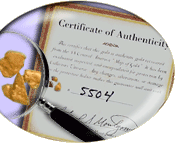What does
"Quintuple Eagle" mean?
What does "Gem Proof"
mean?
Are there other examples of gem
proof gold coins?
Why is the Kellogg $50
Restrike important to numismatic collectors and
investors?
Does a Restrike have value?
What will make the Kellogg
Restrike valuable?
When will Warner Brothers release
the Ship of Gold movie?
How will the general public come to
know about the Kellogg Restrike?
When and where were the
Kelloggs struck?
How will collectors know the
date that the Kelloggs were struck?
How will others know that it is
authentic?
Has the media covered the Restrike
story?
How do I reserve a Kellogg
Restrike Commemorative SS Central America Coin?
What does
"Quintuple Eagle" mean?
In the early 1800s, money was gold. At that time,
America's largest gold coin was the $10 gold piece
with our patriotic eagle on the reverse. The name for
the coin became known as the "Eagle." A $50 piece,
which is five times the size, is called a "Quintuple
Eagle." In fact, the Kellogg Quintuple Eagle is 2
½ times the size of the ever popular Double
Eagle, the largest coin ever produced by the United
States Mint for use in commerce. Without question,
the Kellogg Quintuple Eagle is very large, very heavy
and, in "Gem Proof" condition, unsurpassed in visual
appeal. It is truly amazing to hold such a
magnificent gold piece irrespective of its historical
significance.
[ Back to top ]
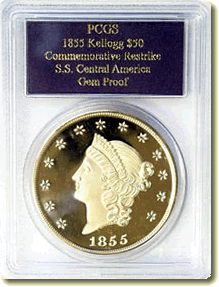 What does "Gem Proof"
mean? What does "Gem Proof"
mean?
To achieve incredibly beautiful and reflective
surfaces, a coin is struck multiple times using
freshly polished dies, which makes it a "proof"
issue. When it is "gem" quality, it means essentially
perfect surfaces free of flaws. Gem Proof coins are
the most cherished by collectors and investors and
certainly most appealing in gold.
[ Back to top ]
Are there other
examples of gem proof gold
coins?
The only other proof gold coin of this size that is
noted in the well known numismatic reference guide,
"The Red Book", is an original Kellogg $50, of which
a dozen are believed to have survived and are valued
at $200,000. Because of their large size and the
aesthetic appeal of the work of its engraver's
design, these are fondly called the "King of
Territorials".
[ Back to top ]
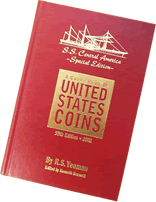 Why is
the Kellogg $50 Restrike important to numismatic
collectors and investors? Why is
the Kellogg $50 Restrike important to numismatic
collectors and investors?
In the eyes of numismatists, John Grover Kellogg is
the most popular of the private coiners of San
Francisco. Throughout our history, few coin dies
survived and it is amazing that Kellogg's original
1855 dies of the "King of Territorials" actually did
survive. Incredibly, these coins are struck with
working dies transferred from John Grover Kellogg's
original 1855 dies and gold from 69 actual California
gold rush monetary ingots produced at his assay
office in San Francisco, and which were recovered
from the SS Central America shipwreck.
Furthermore, because this limited issue is struck
under the authorization and sanction of the
California Historical Society, these coins have
historic and numismatic importance and therefore are
included in the rare coin reference guide "The Red
Book", which is universally used by numismatists.
[ Back to top ]
Does a Restrike have
value?
In at least two cases, a Restrike specimen is more
valuable than an original. The most valuable coin in
the world is the 1804 Silver Dollar that was restuck
in the 1834. One of these sold for over $4,000,000.
Also, many Gobrecht silver dollars were restruck and
issued in the 1860s and now sell for over $50,000 in
gem condition. Another example is the restrike of the
$10 gold Baldwin, which was private "territorial"
gold coinage during the California Gold Rush. As
compared to a Kellogg Restrike, it is a much smaller
piece, struck only in silver (not gold), no "Ship of
Gold" pedigree, not in proof condition, and it was a
simple copy made by a coin dealer in the early 1900s
without using original dies. That said, this coin has
sold at public auction for $3,800 dating back to
1978.
[ Back to top ]
What will make
the Kellogg Restrike valuable?
Supply of this limited issue is less than 5000, while
demand is very strong. Consider that sales have been
brisk without the general knowledge that they are
available for acquisition. The effect of the upcoming
Gold Rush documentary and the inevitability of Warner
Brother's "Ship of Gold" movie may make it difficult
to locate samples to own at whatever the then-current
market price may be in the future. Collectors and
investors simply want to own a piece of the SS
Central America treasure and have a part in the "Ship
of Gold" legend, which is the greatest event in
numismatic history.
[ Back to top ]
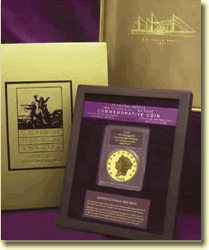 When will
Warner Brothers release the Ship of Gold
movie? When will
Warner Brothers release the Ship of Gold
movie?
The monthly rare coin periodical, "The Numismatist",
reported that Warner Brothers purchased the movie
rights to the "Ship of Gold" story for $800,000. The
novel, "Ship of Gold in the Deep Blue Sea" was a
New York Times Best Seller and an incredible
non-fiction journal of Tommy Thompson's monumental
success at the all-time greatest of American dreams -
finding and keeping hundreds of millions in historic
gold artifacts. Estimates are two years to produce a
movie of this caliber that is budgeted and expected
to rival "Titanic."
[ Back to top ]
How will the general
public come to know about the Kellogg
Restrike?
Besides the overwhelming response from
advertisements, The California Gold Marketing Group
in cooperation with Tommy Thompson and the California
Historical Society is sponsoring a documentary on the
California Gold Rush. This one-hour program should
run frequently on TV much like the History Channel's
"Ship of Gold" documentary.
[ Back to top ]
When and where
were the Kelloggs struck?
By a very special arrangement made by Dwight Manley
and the California Historical Society, all of the
issue were struck (using an old San Francisco Mint
press) at the Presidio in San Francisco commencing
August 20th and
ending September 12th, 2001. These 24 days
coincide with the gold's journey, 144 years prior,
from San Francisco to where it lay preserved under
8000 feet of the Atlantic Ocean.
[ Back to top ]
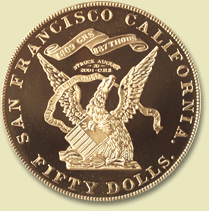 How will collectors know
the date that the Kelloggs were
struck? How will collectors know
the date that the Kelloggs were
struck?
Each coin has a hand applied "counterstamp" noting
the date struck and signifying where the gold was on
its journey, 144 years prior. Counterstamps are
historically important, add numismatic importance and
are desirable to collectors. They were a common
occurrence in those days as recognition of a
merchant's verification of the money's value and as a
means of free advertising.
[ Back to top ]
How will others
know that it is authentic?
Each and every coin is certified authentic and
independently graded Gem Proof by PCGS, the leading
third-party grading service for rare coins. They are
encapsulated and come packaged in the unmistakably
impressive California Historical Society box that
holds the impressive hand-hammered copper
presentation frame.
[ Back to top ]
Has the media covered
the Restrike story?
Coinage Magazine, Coin World Magazine and
the San Francisco Chronicle have released
the story of the Restrike, but the mainstream media
has yet to cover the event. At the first striking,
Tommy Thompson, Bob Evans, several famous
numismatists and the press were present. This would
normally warrant a bit of media coverage but
certainly is not the type of shocking or catastrophic
event that the mainstream media typically
portrays.
[ Back to top ]
How do I reserve a
Kellogg Restrike Commemorative SS Central America
Coin?
Simply call Monaco Financial, an Authorized Dealer,
at 888-900-9948 to reserve your piece of Gold Rush
history. You may also ask about available financing
and opportunities to select a collection of coins
with different striking dates.
[ Back to top ]
|




